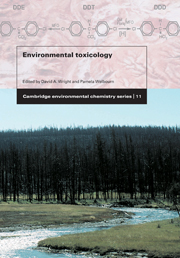Book contents
- Frontmatter
- Contents
- Foreword
- Preface
- Abbreviations
- Acknowledgements
- 1 The emergence of environmental toxicology as science
- 2 The science of environmental toxicology: Concepts and definitions
- 3 Routes and kinetics of toxicant uptake
- 4 Methodological approaches
- 5 Factors affecting toxicity
- 6 Metals and other inorganic chemicals
- 7 Organic compounds
- 8 Ionising radiation
- 9 Complex issues
- 10 Risk assessment
- 11 Recovery, rehabilitation, and reclamation
- 12 Regulatory toxicology
- 13 An overall perspective, or where to from here?
- Glossary
- Index
6 - Metals and other inorganic chemicals
Published online by Cambridge University Press: 05 June 2012
- Frontmatter
- Contents
- Foreword
- Preface
- Abbreviations
- Acknowledgements
- 1 The emergence of environmental toxicology as science
- 2 The science of environmental toxicology: Concepts and definitions
- 3 Routes and kinetics of toxicant uptake
- 4 Methodological approaches
- 5 Factors affecting toxicity
- 6 Metals and other inorganic chemicals
- 7 Organic compounds
- 8 Ionising radiation
- 9 Complex issues
- 10 Risk assessment
- 11 Recovery, rehabilitation, and reclamation
- 12 Regulatory toxicology
- 13 An overall perspective, or where to from here?
- Glossary
- Index
Summary
Introduction
Inorganic contaminants include metals, metalloids, and a number of relatively simple molecules such as phosphate and ammonia. The ways in which inorganic substances can become problematic in the environment, and thus be considered as contaminants, are frequently as a result of their being mobilised or modified chemically by human activities. In contrast to organic contaminants (Chapter 7), many of which are xenobiotic, many inorganic contaminants occur naturally; ecosystems do not distinguish between natural and anthropogenic substances. In terms of their regulation, as well as their management, inorganic contaminants are expected to differ in many respects from xenobiotic substances.
Another point of contrast between inorganic and organic contaminants is that a number of inorganic substances not only are potentially toxic but also are required as nutrients. Such substances exemplify the oft-quoted statement that the dose defines the poison (Paracelsus, c 1493–1541, cited in Rodricks, 1993).
In the context of dose-response, those substances that are nutrients as well as potential toxicants can be put into a simple model, as shown in Figure 6.1, which invokes the concepts of deficiency, sufficiency, and toxicity, successively. For an element such as copper, this succession is theoretically a relatively simple series of transitions. The dose of copper is shown as supply, on the x-axis, and the response as growth rate is shown on the y-axis. Very low doses of copper can result in nutrient deficiency, with below optimum growth; as the supply increases, up to a certain point, there is a positive response. This is the range over which copper is required as a micronutrient.
- Type
- Chapter
- Information
- Environmental Toxicology , pp. 249 - 348Publisher: Cambridge University PressPrint publication year: 2002
- 5
- Cited by



